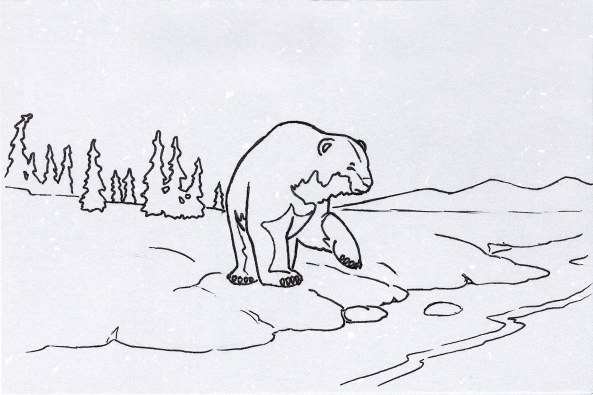Bears in GURPS

Bears are large generalist omnivores of Eurasia and the Americas. They can adapt to most habitats and many different food sources. They have long muzzles, small ears, long and powerful limbs with large claws, very short tails, and a shaggy coat of fur.
Bears rarely roar or growl. Their vocalizations vary from species to species, but typically involve grunts, huffs, smacks, puffs, hums, cries, bawls, screams, and moans.
Bears run with a loping gallop which appears clumsy but which actually covers ground very quickly. When not in a hurry they amble on their big paws - again, the apparent clumsiness of their gait is deceptive, for these are fast and adroit animals whose power and potential ferocity is not to be taken lightly. Bears are strong swimmers, and many species are accomplished climbers. All can use their large claws and powerful limbs to rapidly excave holes or to rip apart logs or many man-made structures. Bears can stand on their hind legs, and frequently do so to look around or to fight, freeing their forelimbs to grab and claw. Their arms and front paws are fairly agile for those of a mammal, and can pick up and manipulate object although rather crudely in human terms - the bear may be able to pick up a soda bottle in both paws but could not screw off the top. Obviously, bears cannot hold things in their hands while moving on all fours, they need to stop and either stand or sit to free their arms.
Bears live in a mostly scent-based world. They use it to find food, communicate with each other, and alert them to other animals in their vicinity. Their sense of hearing is also quite acute. A bear's eyesight, however, is not particularly well developed. It is good at seeing motion but not very good at picking out details. A bear's vision is also better adapted to low light conditions than that of a human. Like most mammals, they cannot distinguish colors in the red-orange-yellow-green part of the spectrum.
Aggressive bears will charge. This may be a bluff - a blustering bear may break off the charge and run away if the target of their charge holds its ground. Or they may follow through, biting and raking with their large claws.
Their attacks may knock a man down, or they may grapple with their front limbs in a tight embrace while clawing and biting.
Bears are often aggressive if defending a food source (particularly a carcass), if it is a mother bear reacting to a perceived threat to her cubs, or if the bear has become habituated to humans and learns that they are a frequent source of food.
Not all bear encounters are aggressive. Usually, bears will either ignore humans or will run away. A scared bear lopes off for cover, or may climb a tree if it is able (not all species can climb well). Bear cubs will cry or scream - an act likely to summon their enraged mother, who is likely to be very aggressive!
Bears eat just about anything - bulbs, roots, shoots, leaves, fruit, grass, nuts, buds, mushrooms, and grains make up the majority of the diet of most species. They eagerly eat meat when it is available, typically most of the animals in their diet are grubs and other insects although in many areas they have a yearly feast when the salmon return to their natal streams. Bears are quite fond of honey, and regularly raid bee nests for honey and grubs. These animals cannot overtake most healthy adults of large, fleet-footed animals such as deer, but they do regularly eat young fawns or scavenge the kills of wolves. They often raid bird nests for eggs and young. When bears come in contact with humans, they will quickly take to knocking over trash cans to forage in the garbage for discarded scraps. They also break into camper's food stores, occasionally even entering vehicles or cabins looking for food, and not uncommonly steal game shot and hung by hunters.
Bears usually make a home in a den, dug out of a tree or the ground, or in a hollow log, cave, or culvert.
In temperate, sub-arctic, and arctic areas, bears sleep through the winter. In order to survive this months-long slumber, they need to build up heavy fat reserves during the rest of the year. Consequently, bears typically weigh considerably more in autumn than they do in spring.
Bears are usually solitary except for mothers with cubs. Cubs will follow their mother, who teaches them the skills they need to survive as adults. Male bears will commonly kill the cubs they encounter. Bears will sometimes tolerate each other's presence in the vicinity of large amounts of food, such as at a large carcass, at trash heaps, or during salmon runs.
Game Statistics
| choose a species:
|
|
Species
| Male
| Female
| (optional)
enter weight (kg)
| T? | HR? | |
| |
The radio button entries in the table above give typical sizes of the bear species of the selected sex. If you want a larger or smaller specimen, enter the weight in kg manually.
Marking the T? checkbox will give you the stats in template form with all costs listed, otherwise you get a stat sheet as for a character.
Marking the HR? checkbox will print the information using all my house rules. Otherwise, the stats will be as compatable with plain vanilla GURPS as possible (although several custom advantages and disadvantages will be present, see my Traits page).
|
Back to Animalia
